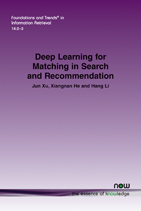Deep Learning for Matching in Search and Recommendation
By Jun Xu, Gaoling School of Artificial Intelligence, Renmin University of China, China, junxu@ruc.edu.cn | Xiangnan He, School of Information Science and Technology, University of Science and Technology of China, China, hexn@ustc.edu.cn | Hang Li, Bytedance AI Lab, China, lihang.lh@bytedance.com
Abstract
Matching is a key problem in both search and recommendation, which is to measure the relevance of a document to a query or the interest of a user to an item. Machine learning has been exploited to address the problem, which learns a matching function based on input representations and from labeled data, also referred to as “learning to match”. In recent years, efforts have been made to develop deep learning techniques for matching tasks in search and recommendation. With the availability of a large amount of data, powerful computational resources, and advanced deep learning techniques, deep learning for matching now becomes the state-of-the-art technology for search and recommendation. The key to the success of the deep learning approach is its strong ability in learning of representations and generalization of matching patterns from data (e.g., queries, documents, users, items, and contexts, particularly in their raw forms).
This survey gives a systematic and comprehensive introduction to the deep matching models for search and recommendation developed recently. It first gives a unified view of matching in search and recommendation. In this way, the solutions from the two fields can be compared under one framework. Then, the survey categorizes the current deep learning solutions into two types: methods of representation learning and methods of matching function learning. The fundamental problems, as well as the state-of-the-art solutions of query-document matching in search and user-item matching in recommendation, are described. The survey aims to help researchers from both search and recommendation communities to get in-depth understanding and insight into the spaces, stimulate more ideas and discussions, and promote developments of new technologies.
Matching is not limited to search and recommendation. Similar problems can be found in paraphrasing, question answering, image annotation, and many other applications. In general, the technologies introduced in the survey can be generalized into a more general task of matching between objects from two spaces.
Deep Learning for Matching in Search and Recommendation
Matching, which is to measure the relevance of a document to a query or interest of a user to an item, is a key problem in both search and recommendation. Machine learning has been exploited to address the problem and efforts have been made to develop deep learning techniques for matching tasks in search and recommendation. With the availability of a large amount of data, powerful computational resources, and advanced deep learning techniques, deep learning for matching now becomes the state-of-the-art technology for search and recommendation.
The key to the success of the deep learning approach is its strong ability in learning of representations and generalization of matching patterns from data. This survey gives a systematic and comprehensive introduction to the deep matching models for search and recommendation. First, it gives a unified view of matching in search and recommendation and the solutions from the two fields can be compared in one framework. Then, the survey categorizes the current deep learning solutions into two types: methods of representation learning and methods of matching function learning. The fundamental problems as well as the state-of-the-art solutions of query-document matching in search and user-item matching in recommendation are described.
Deep Learning for Matching in Search and Recommendation aims to help researchers from both search and recommendation communities to get an in-depth understanding and insight into the spaces, stimulate more ideas and discussions, and promote developments of new technologies. As matching is not limited to search and recommendation, the technologies introduced here can be generalized into a more general task of matching between objects from two spaces.
